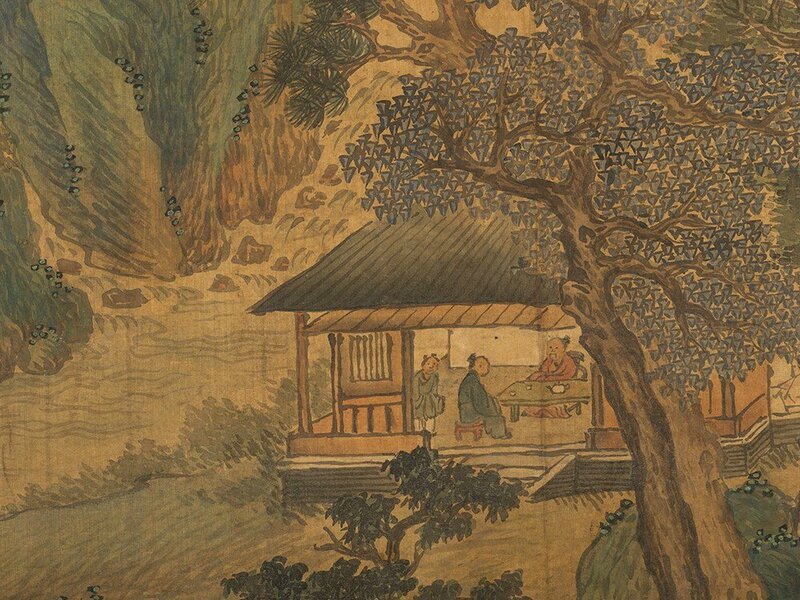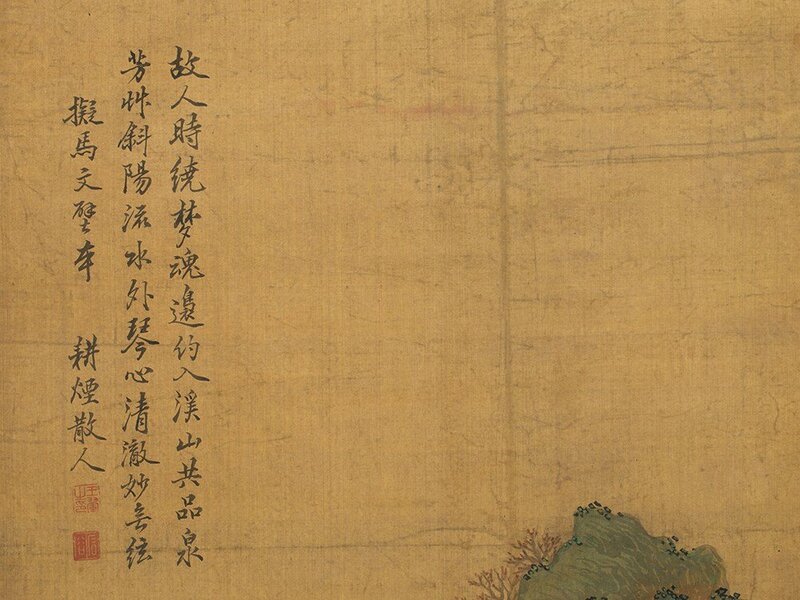Wang Hui (1632-1717), Scroll ‘Landscape with Literati’, China
Wang Hui (1632-1717), Scroll ‘Landscape with Literati’, China. Photo courtesy Auctionata.
Wang Hui (1632-1717) – master of Chinese painting. With calligraphy, artist’s signature ‘Geng Yan San Ren’ ???? and two seals Mounted on paper in a silk frame. Overall dimensions: 251 x 50 cm. Image size: 163.5 x 38.5 cm. The scroll painting shows signs of age and wear. The material is a little browned. There are creased which are less visible due to the mounting. One of the handles is missing. Estimate €6,400 – €8,000
Provenance: from a German private collection, acquired in Burma in 1970
This breathtaking landscape was painted by the master of Chinese painting Wang Hui (1632-1717). It shows a landscape in shades of blue and green, which extends across different perspectival planes. The structure is strongly vertical. Steep, towering mountains and a waterfall define the composition. The wide open space and the romantic atmosphere of the landscape are masterfully rendered. Following the example of his mentor Wang Shimin, Wang Hui often relates to the classical models of the Chinese painting tradition in his paintings. Thus the composition is reminiscent of works by Wang Meng (1308-1385), the famous Chinese landscape painter of the 14th century. Wang Hui’s depictions of nature are never mere copies but always a synthesis of historical landscape paintings, in which he exhibits his skilful brushwork. The subject of this work is described in the calligraphy: literati meet in a hut on a river in the mountains. The friends taste the water of the spring, listen to the sound of the zither and enjoy the idyll.
The inscription in the upper left reads ‘In the style of Ma Wen Bi ??? (also Ma Wan ??, painter of the Yuan Dynasty), painted by Geng Yan San Ren ????’. Wang Hui had the courtesy name Shigu or Shiguzi and the epithet Geng Yan San Ren, which can be identified here in the inscription. There are also two seals in the upper left.
The work is mounted on paper in a silk frame. The painting has a suspension. There is a label with the inscription ‘scroll painting of a landscape by Wang Shigu ??? (epithet of Wang Hui)’ on the back of the mount.
Wang Hui (1632-1717).
Wang Hui was born into a family of artists and learned his craft at a very early. Later he was a pupil of Zhang Ke and Wang Shimin, two artists of the so-called 'orthodox school', which was dedicated to the tradition of Chinese painting in particular the icism of the painter Dong Qichang. Wang Hui was a follower of literati painting and his works were highly sought after by collectors during the artist's lifetime. Even the Kangxi Emperor appreciated the painter's masterly executed landscapes. Thus Wang was appointed to the imperial court to create a series of works between 1691 and 1698. Wang Hui is one of the 'Four Great Masters' from the Kangxi period and his works are some of the world's most expensive old master paintings.
Auctionata. Fine Asian Art. March 28. Kurfurstendamm 212, Berlin, 10719 Germany. www.liveauctioneers.com

/https%3A%2F%2Fprofilepics.canalblog.com%2Fprofilepics%2F1%2F0%2F100183.jpg)
/https%3A%2F%2Fstorage.canalblog.com%2F03%2F02%2F119589%2F96711876_o.jpg)
/https%3A%2F%2Fstorage.canalblog.com%2F11%2F31%2F119589%2F94773502_o.jpg)
/https%3A%2F%2Fstorage.canalblog.com%2F20%2F83%2F119589%2F94772815_o.jpg)
/https%3A%2F%2Fstorage.canalblog.com%2F26%2F72%2F119589%2F75604929_o.jpg)
/https%3A%2F%2Fstorage.canalblog.com%2F59%2F60%2F119589%2F26458628_o.jpg)









/http%3A%2F%2Fstorage.canalblog.com%2F64%2F14%2F119589%2F127653026_o.jpg)
/http%3A%2F%2Fstorage.canalblog.com%2F23%2F85%2F119589%2F122208401_o.jpg)
/http%3A%2F%2Fmfas3.s3.amazonaws.com%2Fstyles%2Fbanner_grid-9_retina%2Fs3%2F4x3_5.jpg%3Fitok%3DuPwc7dFt)
/http%3A%2F%2Fstorage.canalblog.com%2F68%2F55%2F119589%2F112523464_o.jpg)